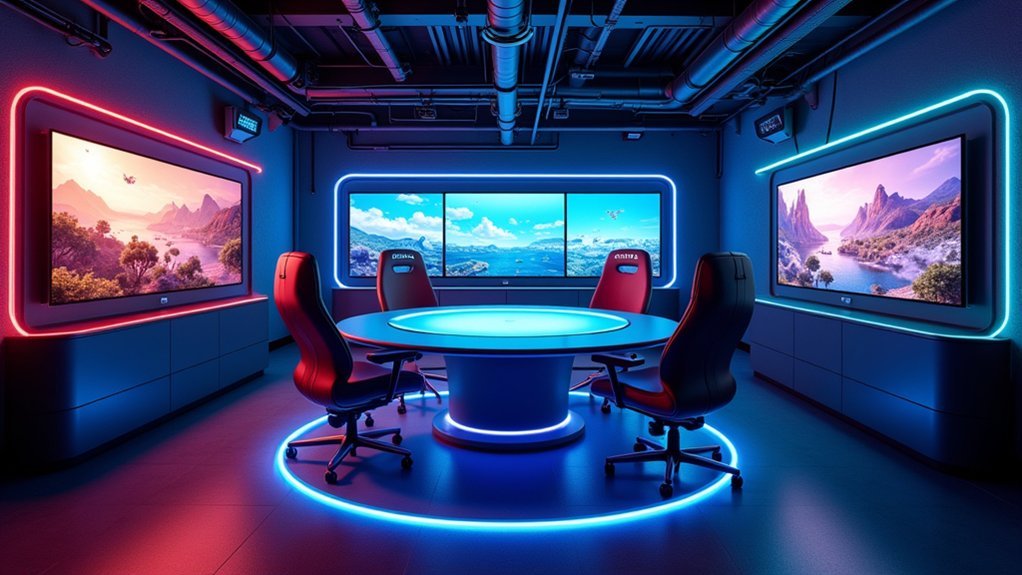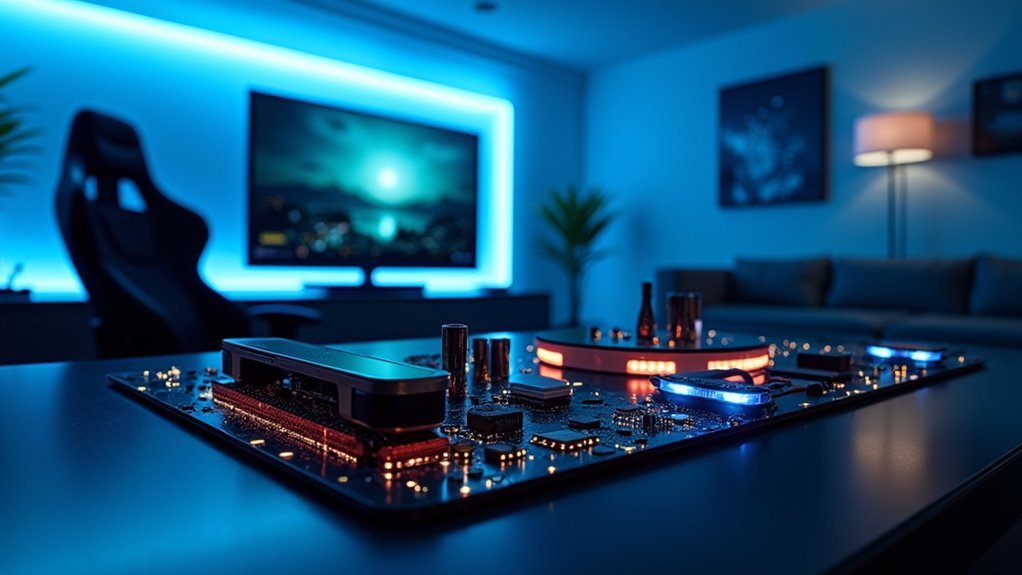You’ll need to secure a minimum 55 m² space with 2.80m ceiling clearance and install mmWave technology capable of delivering 6+ Gbps data rates for seamless wireless VR experiences. Set up phased array antennas and programmable mirror arrays to eliminate cable constraints while ensuring proper power infrastructure with dual 16A lines. Focus on creating multiplayer zones that accommodate four players safely, then develop revenue streams through memberships, tournaments, and community engagement strategies that’ll transform your gaming hub into a profitable venture.
Understanding Mmwave Communication Technology for VR Systems

Several cutting-edge wireless gaming hubs now leverage mmWave communication technology to deliver the ultra-high bandwidth that VR systems demand.
You’ll achieve data rates exceeding 6 Gbps, providing the throughput necessary for high-resolution VR content transmission. This technology uses phased arrays to maintain focused signal beams, tracking your headset movements within a precise two-degree detection range.
Unlike traditional untethered VR solutions requiring bulky hardware, mmWave eliminates HDMI cables, creating lightweight, mobile setups.
mmWave technology transforms VR gaming by removing cable constraints, delivering unprecedented mobility without sacrificing the high-performance capabilities gamers demand.
However, you’ll face challenges with signal obstruction and reflection issues that require advanced signal direction maintenance for seamless communication.
Future mmWave developments promise compact devices potentially smartphone-sized, enabling more versatile applications in multiplayer gaming and creating truly immersive wireless environments for your gaming hub.
Selecting the Right Location and Space Requirements
You’ll need to secure a location with adequate space dimensions and clearance to support your wireless VR systems effectively.
Your chosen venue must have robust power and internet infrastructure capable of handling data-intensive gaming experiences without interruption.
Don’t overlook accessibility requirements and safety compliance standards, as these factors directly impact your hub’s success and legal operation.
Space Dimensions and Clearance
When establishing a wireless gaming hub, determining adequate space dimensions forms the foundation of a successful setup.
You’ll need minimum dimensions of 55 m² (1717 ft²) for a 4-player HOLOGATE system, while a 2-player configuration requires at least 52.5 m² (178.5 ft²). Essential vertical clearance of 2.80 m guarantees players can move freely without restrictions.
Design your space to eliminate obstacles that could impede gameplay or cause safety concerns.
You’ll want to allocate additional room beyond these minimums for spectator viewing areas, equipment storage, and ancillary services that enhance user experience.
Consider traffic flow patterns and emergency exits when planning your layout.
Strategic space planning maximizes both player safety and operational efficiency, creating an environment where users can fully engage with the wireless gaming experience.
Power and Internet Infrastructure
Beyond securing adequate physical space, establishing reliable power and internet infrastructure determines whether your wireless gaming hub operates seamlessly or suffers from frustrating interruptions.
You’ll need at least two 16A fused power lines with grounded connections to meet the power requirements of VR equipment and gaming systems. Without sufficient electrical capacity, your equipment won’t function properly or could face dangerous power fluctuations.
Your internet connection demands equal attention. You must obtain high-speed fiber or cable internet capable of sustaining data rates above 6 Gbps.
This bandwidth guarantees real-time VR processing without lag, which is critical for immersive gameplay. Slower connections will create delays that break the VR experience and frustrate players.
Test your connection speeds thoroughly before committing to any location.
Accessibility and Safety Compliance
Electrical and network infrastructure alone won’t guarantee a successful wireless gaming hub if your location fails to meet accessibility standards and safety regulations.
You’ll need to conduct a thorough site inspection to verify your venue complies with local fire codes and occupancy limits. Confirm that accessibility features like ramps and restrooms accommodate users with disabilities, making your gaming hub inclusive for everyone.
Your space must provide minimum vertical clearance of 2.80 meters to prevent equipment damage during gameplay.
For a 4-player system, you’ll require approximately 55 m² of floor space, allowing players to move freely and safely.
Don’t forget to validate adequate internet connectivity and proper electrical setup with 2x 16A fused power lines and grounded connections.
Installing Programmable Mirror Arrays for Signal Direction
You’ll need to position your programmable mirror arrays strategically throughout your gaming hub to maximize mmWave signal coverage and maintain that essential two-degree accuracy for VR headsets.
Start by identifying key zones where users will move most frequently, then mount the compact arrays at ideal angles to redirect signals around obstacles.
Focus on creating overlapping coverage areas while fine-tuning each array’s phased configuration to achieve those 6+ Gbps data rates your high-resolution VR applications demand.
Array Placement Strategies
When positioning programmable mirror arrays in your gaming hub, you’ll need to map out sight lines that maximize mmWave signal coverage while avoiding physical obstructions.
Your array placement strategies should prioritize clear paths between mirrors and VR headsets, ensuring uninterrupted signal reflection. Position arrays at ceiling corners or wall-mounted locations that provide ideal visibility across the gaming space.
Consider your room’s layout carefully—furniture, pillars, and other obstacles can block mmWave signals and disrupt your VR system’s performance.
Place arrays strategically to create overlapping coverage zones, allowing seamless handoffs as players move throughout the space. The compact antenna design, measuring less than half a credit card’s size, offers flexible mounting options.
Proper positioning maintains the essential 6+ Gbps data rates needed for high-resolution VR experiences.
Signal Optimization Techniques
With your arrays properly positioned, focus shifts to fine-tuning signal optimization through precise beam steering and reflection control. Your programmable mirrors detect incoming mmWave signals within two-degree accuracy, enabling focused beam direction toward VR headsets. These signal optimization techniques maintain data rates exceeding 6 Gbps, essential for real-time processing.
Configure your phased array antennas—smaller than half a credit card—to dynamically track moving headsets without physical constraints. The arrays automatically adjust reflection angles, compensating for environmental obstacles and interference that typically degrade wireless performance.
Fine-tune beam parameters by monitoring signal strength indicators and adjusting mirror orientations accordingly. This continuous optimization guarantees consistent connectivity as users move throughout your gaming space, eliminating the bulky hardware traditionally required for untethered VR solutions while maximizing user mobility and immersive experiences.
Configuring Phased Array Antennas for Optimal Performance

Since phased array antennas form the backbone of high-performance wireless gaming hubs, you’ll need to understand their configuration process to achieve ideal VR experiences.
These compact systems use multiple antenna elements smaller than half a credit card, making integration seamless without adding bulk to your setup.
You’ll configure each element’s phase and amplitude to create directional beams that dynamically steer as VR headsets move. This maintains peak signal quality through precise tracking within two degrees of accuracy.
The configuration enables sustained data rates exceeding 6 Gbps, essential for real-time processing of high-resolution content.
Focus on beam steering calibration and element synchronization during setup. Proper configuration guarantees your phased array antennas deliver focused transmission and reception, eliminating lag and disruptions for seamless wireless VR gaming experiences.
Setting Up Multiple Compact Wireless Devices
Once you’ve mastered phased array antenna configuration, you’ll need to strategically deploy multiple compact wireless devices throughout your gaming space.
Position each MoVR system to deliver data rates exceeding 6 Gbps, ensuring smooth high-resolution VR performance without lag. Space devices to account for potential obstacles and signal reflections that could disrupt mmWave connectivity.
Strategic MoVR placement demands 6+ Gbps data rates while accounting for obstacles and mmWave signal reflections that compromise high-resolution VR performance.
Install programmable mirror systems with each device to detect incoming signal direction within two degrees, maintaining stable connections as players move freely. This setup enables true multiplayer immersive experiences without physical tethering constraints.
Consider room layout carefully—place devices at varying heights and angles to eliminate dead zones.
Test each position thoroughly, ensuring seamless handoffs between devices as users navigate your gaming hub. Multiple compact units create redundancy and expanded coverage zones.
Implementing Edge Computing Infrastructure

After establishing your wireless device network, you’ll need to deploy edge computing infrastructure that processes data locally rather than routing everything to distant cloud servers. This reduces latency considerably, keeping your VR experiences immersive and responsive.
Install mobile edge computing (MEC) servers near your gaming area to handle the intensive computational workload that VR applications demand.
Your edge computing setup should optimize bandwidth allocation and resource management automatically. Implement a dynamic framework using continual reinforcement learning to adapt to changing network conditions and user demands.
This prevents latency-induced motion sickness by offloading processing tasks from VR headsets to nearby servers.
Ensure your network infrastructure supports data rates exceeding 6 Gbps for high-resolution VR experiences without cables.
Establishing Network Architecture for 6+ Gbps Data Rates
You’ll need to architect a network backbone that sustains 6+ Gbps throughput to eliminate VR latency and deliver seamless gaming experiences.
Your infrastructure must incorporate mmWave technology with phased array antennas since traditional WiFi can’t handle these demanding data rates.
Focus on implementing bandwidth optimization strategies that account for signal reflections and maintain robust directional connectivity as gamers move throughout your wireless hub.
High-Speed Infrastructure Requirements
Three critical components form the backbone of any wireless gaming hub capable of delivering the 6+ Gbps data rates that modern VR experiences demand.
You’ll need programmable mirrors that redirect mmWave signals with precision, ensuring high throughput reaches every corner of your gaming space.
Phased array antennas provide the second element, offering directional beam steering that eliminates traditional HDMI cable requirements while maintaining signal focus.
Your infrastructure’s third pillar involves robust QoS protocols that minimize latency and prevent packet loss.
Since you can’t rely on compression for real-time VR applications, you’ll handle uncompressed video streams directly. This approach prevents motion sickness and maintains seamless gameplay.
Multiple mmWave devices working collaboratively will enhance multi-user experiences while preserving reliable connectivity throughout your wireless gaming environment.
Bandwidth Optimization Strategies
While traditional bandwidth management relies on static allocation methods, dynamic resource distribution becomes essential when establishing network architecture for sustained 6+ Gbps data rates. You’ll need deep reinforcement learning algorithms that adapt resource allocation based on real-time conditions and user demands.
| Technology | Data Rate | Application |
|---|---|---|
| mmWave | 6+ Gbps | Untethered VR |
| Phased Arrays | Variable | Beam Focusing |
| Smart Mirrors | Enhanced | Signal Direction |
Your bandwidth optimization strategies should incorporate mmWave technology for multi-Gbps wireless transmission. Deploy phased array antennas to focus signal beams, minimizing interference while maximizing bandwidth utilization. Implement programmable mirrors to enhance signal directionality, maintaining consistent connectivity as VR headsets move throughout your gaming space.
Designing Multiplayer Gaming Zones Without Cable Constraints
When you’re designing multiplayer gaming zones without cable constraints, you’ll need to harness advanced wireless communication technologies that can handle the demanding requirements of modern gaming. mmWave technology delivers data rates exceeding 6 Gbps, making it essential for real-time VR processing and high-resolution experiences.
The MoVR system demonstrates how programmable mirrors eliminate HDMI cables while maintaining signal direction, ensuring seamless connectivity as players move around.
You’ll want to focus on these key design elements:
- Phased array antennas that focus signal beams for reliable connections
- Strategic layout planning to prevent interference between multiple devices
- Dynamic tracking systems that adapt to player movement
- Future-ready infrastructure supporting smartphone-sized devices for multiple users
This approach creates immersive multiplayer environments where wireless freedom enhances gameplay without sacrificing performance.
Integrating Safety Protocols and Hygiene Standards
Since wireless gaming hubs accommodate multiple users throughout the day, you’ll need robust safety protocols and hygiene standards that protect players while maintaining operational efficiency.
Start by implementing thorough cleaning solutions for all equipment, ensuring compliance with location-based entertainment regulations. Sanitize VR headsets and controllers between each user, providing sanitizing wipes and clear instructions for maintaining cleanliness.
Establish detailed user instructions that include safety guidelines for headset usage and equipment handling. Maintain sufficient backup equipment to address technical issues quickly, minimizing disruptions while ensuring safe gameplay environments.
Promote your hygiene standards through engaging communication strategies like social media updates, informing users about protective measures you’ve implemented. These protocols build trust and demonstrate your commitment to player safety.
Revenue Generation Through Memberships and Tournament Events
With your safety protocols established and players confident in your facility’s standards, you can focus on building sustainable revenue streams that maximize your hub’s profitability.
Implementing a membership model provides steady monthly income while creating customer loyalty. You’ll want to design multiple membership tiers to capture different market segments and spending levels.
Tournament events generate significant additional revenue through multiple channels:
- Entry fees from competitive participants seeking prizes and recognition
- Corporate sponsorships from gaming brands and local businesses
- Concession sales during events when spectator attendance peaks
- Merchandise sales featuring your hub’s branding and tournament memorabilia
You can supplement these primary revenue sources with ancillary services like game rentals and party packages, creating a thorough income ecosystem that supports long-term financial sustainability.
Marketing Your Wireless VR Gaming Hub to the Community
How effectively can you reach potential customers who’ve never experienced wireless VR gaming? Start by leveraging social media platforms to showcase your hub’s unique experiences and community events.
Create visually appealing videos demonstrating gameplay and featuring satisfied customer testimonials to communicate the excitement effectively.
Collaborate with local schools and community organizations to host educational VR workshops, fostering youth and parent interest.
Offer introductory deals or free trial sessions, encouraging newcomers to experience the immersive experience firsthand and share their reactions.
Organize community tournaments and competitive events that promote social interaction and attract diverse audiences.
These gatherings enhance community involvement while creating buzz around your gaming center.
Focus on highlighting what makes wireless VR unique compared to traditional gaming options.
Frequently Asked Questions
How to Make Steam VR Wireless?
You’ll implement the MoVR system’s mmWave technology to eliminate HDMI cables from your Steam VR setup. Install phased array antennas that’ll maintain signal direction, delivering over 6 Gbps for seamless wireless gaming.
How Do I Start VR Gaming Center?
You’ll need to research your local market first, then secure funding and location. Invest in quality VR equipment, design an engaging space, build a diverse game library, and create revenue streams.
What VR Is Best for Games?
You’ll find Oculus Quest 2 offers the best balance of wireless freedom and game library for most users. Valve Index delivers premium visuals if you’re willing to sacrifice mobility for top-tier graphics and tracking precision.
How to Setup a Gaming Center?
You’ll need to secure a suitable location, install high-speed internet, purchase quality gaming equipment, create comfortable seating areas, develop pricing strategies, obtain necessary permits, and market your center through social media campaigns.
In Summary
You’ve now got the blueprint for launching your wireless VR gaming hub. Remember, mmWave technology and proper antenna configuration are your foundation, but location and safety protocols can’t be overlooked. Focus on creating an immersive multiplayer experience that’ll keep customers coming back. With strategic marketing and diverse revenue streams through memberships and tournaments, you’ll transform this cutting-edge entertainment concept into a profitable business that revolutionizes how your community experiences virtual reality gaming.





Leave a Reply